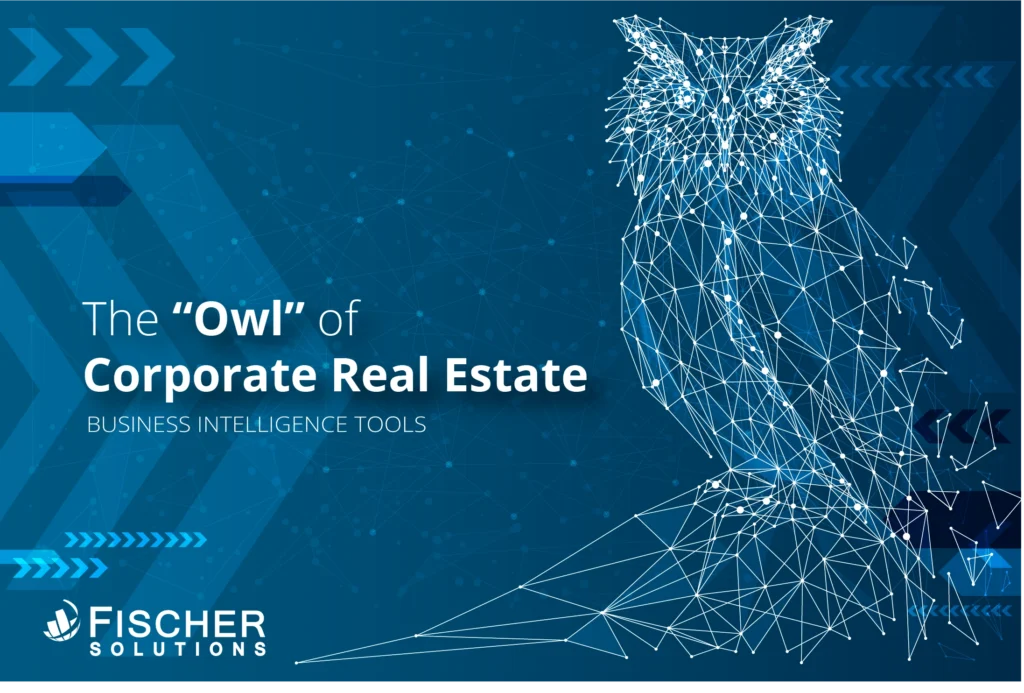Business Intelligence: The “Owl” of Corporate Real Estate
Business Intelligence tools transform raw data into consumable information, but translating the findings can oftentimes be difficult to interpret. The art of conveying ideas effectively is a timeless challenge that transcends boundaries. From subtle nuances lost in translation to finding the right words to captivate an audience, conveying ideas requires finesse.
Business intelligence (BI) refers to the data analysis and reporting tools used to identify trends, patterns, and opportunities. Analytics help to gain insights and make informed business decisions related to real estate operations, investment, and overall business strategy.
In this blog, we’ll talk about how to interpret data sources to positively affect business performance. I’ll give you my first-hand experience and break down what you need to know about business intelligence tools. Keep reading to see why I like to refer to the term “business intelligence” as the “owl” of corporate real estate.

Bridging the Business Intelligence Gap
As an industrial engineer, my time is essentially spent as a BI interpreter working with a diverse range of stakeholders. I find myself constantly bridging the gap between technical concepts and practical implementation. Efficiently facilitating effective communication among clients, executives, brokers, programmers, and many others.
Business intelligence for corporate real estate serves two primary functions in the form of answering two sets of questions:
- Reporting: What do we have and what are we doing?
- Analytics: What are the opportunities and what are our options?
The goal is to empower real estate professionals and decision-makers with actionable insights. Subsequently optimizing operations, enhancing profitability, mitigating risks, and making informed investment decisions.
What do we have and what are we doing?
Reporting is most frequently associated with portfolio metrics or transaction and capital projects details. For portfolio metrics, business intelligence provides a comprehensive view of the corporate real estate portfolio, encompassing:
- the current state
- changes over time
- data quality monitoring
It consolidates data on assets, leases, occupancy rates, financial performance, and other key metrics into intuitive dashboards and reports.
Decision-makers can assess the portfolio’s health, identify trends, and make informed strategic decisions based on accurate and reliable information. Additionally, data quality monitoring ensures the integrity and accuracy of the portfolio data. Thus, enabling stakeholders to have confidence in the insights derived from the business intelligence system.
BI tools for transactions and capital projects offer a range of capabilities to support effective management. It provides resource monitoring, allowing decision-makers to track and allocate resources efficiently.
- Capacity planning features enable organizations to optimize resource utilization. Ensuring that projects are adequately staffed while individual resources are not over-booked risking burn-out.
- Risk mitigation is facilitated through the identification and analysis of upcoming critical dates, milestones, and other potential project risks. Enabling proactive measures to be taken before major costly issues arise.
- Historical analysis of processes provides insights into past projects, helping improve future project planning and execution.
By leveraging business intelligence, organizations can enhance project efficiency, minimize risks, and drive successful outcomes for transactions and capital projects.
What are the opportunities and what are our options?
Typically, business analytics are associated with two levels: portfolio level and transaction level.
Portfolio Level – Strategic Planning
For strategic planning, business intelligence provides essential insights and tools to guide decision-making. It facilitates the development of portfolio plans by analyzing key factors such as asset performance, market trends, and business goals.
Decision-makers can assess the magnitude of opportunities within their real estate portfolio, identifying areas for growth, consolidation, or optimization. By comparing plan versus actual data, organizations can evaluate the effectiveness of their strategic initiatives and make data-driven adjustments to optimize performance.
Business intelligence empowers stakeholders to align their real estate portfolio with broader business objectives. Thus, ensuring a proactive and strategic approach to portfolio management.
Transaction Level – Tactical Delivery
For transaction analysis, business intelligence equips decision-makers with valuable tools to evaluate potential real estate transactions. It facilitates rent forecasting by analyzing historical market rates, vacancy trends, and economic indicators.
This enables organizations to project future rent obligations and make informed decisions regarding lease negotiations and lease versus buy decisions.
- Market studies provide comprehensive insights into local real estate markets. This helps organizations understand supply and demand dynamics, competitive landscapes, and market trends.
- Drive-time analysis enables the assessment of employee retention. Analyzing potential relocations and accessibility and proximity to target markets, customers, and suppliers, supporting informed location decisions.
- Demographic studies leverage data on population, income levels, and consumer behavior. Informing decisions related to labor availability and wages, target markets, and customer bases.
Leveraging business intelligence for transaction analysis enables organizations to make informed, data-driven decisions. All the while optimizing lease negotiations, identifying prime locations, and mitigating risk in their real estate transactions.
The Owl of Corporate Real Estate
Let’s get back to “conveying ideas” though. There have been many great analogies used regarding the role of business intelligence in corporate real estate. Not only are they fun and engaging to follow, but they help the underlying “ideas” stick with the audience.
One of my favorites involved comparison to “The Wizard of Oz”. However, I usually go with more traditional analogies involving sports cars, tractor-trailers, sporting teams, and others. It all depends on the audience of course.
Let’s introduce an analogy that most likely will never see the light of a boardroom, but it was fun to think about, nevertheless. As a father of four young children, conveying ideas in a way they can understand and retain the premises is paramount. If I had to explain business intelligence for corporate real estate to them, I would compare it to the owl.
Business Intelligence vs. The Owl
Why? (I get that question a lot.) First is their wisdom.
Wisdom
Owls are often associated with wisdom and knowledge. In corporate real estate, BI platforms provide decision-makers with valuable insights and data-driven information to make informed decisions. Like an owl, business intelligence helps illuminate the past, present, and path forward. In turn, guiding stakeholders with its wisdom and enables them to navigate complex real estate dynamics.
Vision
Owls have excellent vision and can see things from a distance and in the dark. Similarly, BI provides a clear view of real estate portfolios, market trends, financial performance, and other crucial factors. It provides decision-makers with the ability to spot opportunities, identify risks, and make strategic choices.
Adaptability
Owls are adaptable creatures that can thrive in various environments and circumstances. Similarly, business intelligence empowers decision-makers to adapt to changing market conditions, industry trends, and evolving business needs. It enables them to adjust their strategies, optimize resources, and make timely decisions based on real-time data and analytics.
Stealthy
Owls are known for their silent flight and efficient hunting techniques. Similarly, business intelligence operates silently in the background, continuously collecting, analyzing, and processing vast amounts of data. It enables decision-makers to leverage insights from the data to optimize real estate operations, streamline processes, and achieve better outcomes.
Awareness
Owls are highly observant and have excellent situational awareness. They can detect even the slightest movements or changes in their surroundings. Similarly, business intelligence enables decision-makers to be observant and alert to critical real estate indicators, market trends, and performance metrics. It helps them stay vigilant and respond proactively to emerging opportunities or potential risks.
Timely
Owls are primarily nocturnal animals, being most active during the night. BI operates around the clock, continuously monitoring and analyzing real estate data to provide up-to-date information and insights. It ensures access to accurate and timely data whenever it is needed, even during the “nighttime” of business operations.
Skilled “Hunter”
Owls are skilled predators, capable of hunting effectively and efficiently. In the realm of corporate real estate, business intelligence helps decision-makers “hunt” for opportunities, optimize asset performance, and mitigate risks. It equips them with the necessary tools and information to make strategic decisions that maximize returns and drive success.
Conclusion
When describing business intelligence for corporate real estate, one can opt for direct definitions or analogies to convey its essence. Direct definitions provide a concise and precise explanation of the concept. Highlighting its role in consolidating and analyzing real estate data for informed decision-making.
On the other hand, analogies offer a more relatable and visual approach. Likening business intelligence to a trusted guide navigating the complex terrain of corporate real estate.
Analogies can paint a vivid picture of how business intelligence empowers organizations. Unlocking the hidden potential of their real estate portfolios. Much like a compass guiding explorers through uncharted territories.
Effectively describing business intelligence for corporate real estate enables stakeholders to grasp its transformative power. Thus, unleashing its benefits for strategic decision-making and operational excellence.

